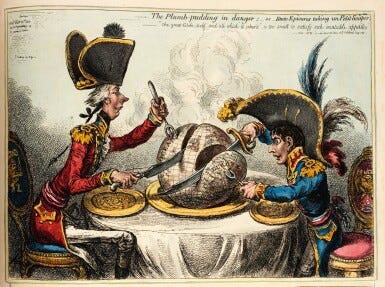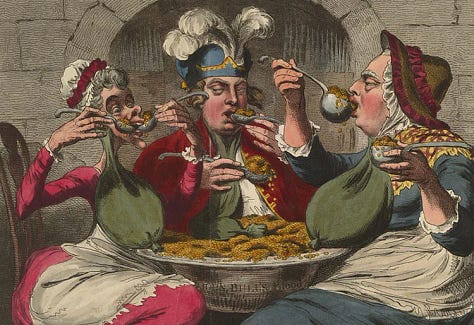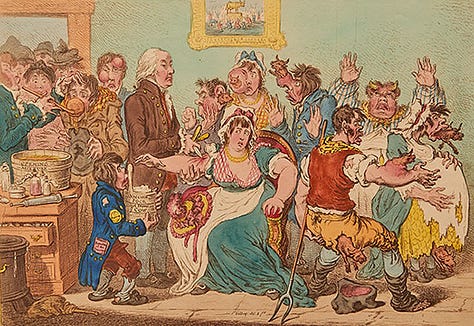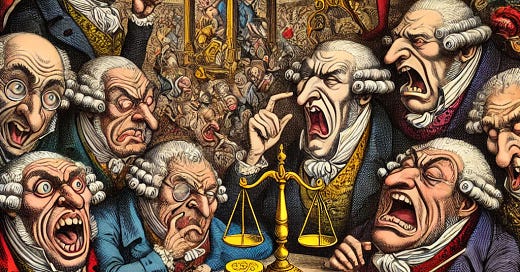James Gillray (1756–1815): The Razor-Sharp Eye of Georgian Satire
Honoring the Satirists and Thinkers Who Altered Our Perspectives #68
Voice-over provided by Amazon Polly
Also, check out Eleven Labs, which we use for all our fiction.






Preface
Few satirists have left as deep an imprint on political caricature as James Gillray. An English printmaker and cartoonist, Gillray wielded his etching needle like a rapier, skewering politicians, monarchs, and social figures of late 18th and early 19th century Britain with unparalleled wit. His exaggerated and often grotesque portrayals of public figures not only entertained but also shaped public opinion, cementing his status as one of the most influential satirists of his time. His works did not merely ridicule but often carried an underlying critique of power, corruption, and incompetence, making them both humorous and politically potent.
From lampooning King George III’s eccentricities to mocking Napoleon Bonaparte’s imperial ambitions, Gillray’s work remains a benchmark for political satire, inspiring generations of cartoonists and artists who followed. His visual language was one of stark contrasts—exaggerated physiognomies, symbolic props, and densely packed compositions, all working in tandem to deliver sharp political commentary. With his ability to distill complex political tensions into a single, striking image, Gillray’s prints became a staple of British political discourse, displayed in print shop windows and avidly discussed in coffeehouses and salons alike.
Early Life and Influences
Born in 1756 in Chelsea, England, Gillray was the son of a former soldier turned letterpress printer. Raised in an environment rich with print culture, he was exposed early to the power of visual storytelling. Books, pamphlets, and broadsheets were a constant presence in his childhood home, and from an early age, he showed a talent for drawing, often sketching figures he observed in the streets of London.
At an early age, he was sent to a Moravian religious community for schooling, but the rigid life of religious devotion did not suit his temperament, and he soon returned to London. The disciplined, austere environment of the Moravians left a lasting impression on him, though not in the way his teachers intended—his later satirical works often ridiculed religious hypocrisy and rigid moralism.
Drawn to art, Gillray enrolled at the prestigious Royal Academy, where he studied under influential artists such as Francesco Bartolozzi. There, he honed his skills in etching and engraving, developing a keen eye for composition and figure drawing. Initially, he aspired to become a painter, but the limited opportunities for financial success in fine art led him to explore other avenues. His natural inclination toward caricature and satire soon pulled him toward the booming world of printmaking.
The streets of London provided an endless source of inspiration for Gillray. The bustling markets, rowdy taverns, and political debates of the city fed his imagination, giving him a deep understanding of both the common people and the elite. Inspired by William Hogarth’s narrative engravings and the scathing wit of contemporary pamphleteers, Gillray found his calling in the growing field of political caricature, a medium that had begun to flourish amid Britain’s turbulent political climate.
Major Works and Themes
Gillray’s career spanned a period of immense political upheaval: the American Revolution, the French Revolution, and the Napoleonic Wars all played out in the backdrop of his art. These events reshaped Europe, ushering in new political ideologies and redefining the balance of power. His biting satire targeted figures from both sides of the political spectrum, making his work not just entertainment but a significant part of the political discourse of the era. His prints served as both commentary and propaganda, influencing public perception of key figures and global conflicts.
Gillray's ability to translate complex political events into powerful visual allegories meant that his work resonated across class divisions. His engravings did not merely entertain the elite but also reached broader audiences through mass distribution. London’s print shops often displayed his latest creations in their windows, where crowds would gather to examine and discuss the political implications. His sharp humor and distinctive style made his prints highly sought after, not only in Britain but also across Europe. The accessibility of his work helped shape popular opinion on domestic and international affairs, making him an indispensable voice in the political landscape of his time.
Critique of Society and Power
Gillray’s etchings often exposed the corruption, hypocrisy, and absurdities of the ruling class. He was particularly ruthless toward the British monarchy and government, portraying King George III as a buffoonish, hapless ruler in several pieces. His depictions of the king often exaggerated his perceived incompetence and mental instability, a theme that became a recurring motif in British satire of the time. One of his most famous works, The King of Brobdingnag and Gulliver (1803), shows George III peering at a miniature Napoleon through a spyglass, reflecting Britain’s perception of the French emperor as an overambitious, albeit small, threat. In another well-known print, Farmer George and his Wife (1792), Gillray mocked the king’s obsession with agriculture and his simple-mindedness, portraying him and Queen Charlotte as rustic peasants oblivious to the pressing political concerns of the nation.
At the same time, Gillray was known to be politically ambidextrous, taking jabs at both radical reformers and conservative reactionaries. He attacked William Pitt the Younger with equal ferocity, often portraying him as a skeletal, ghostly figure obsessed with taxation and control. His 1797 print The New Morality lampooned both radical Jacobins and conservative moralists, critiquing the British government’s attempt to police public behavior.
His work was often distributed by Hannah Humphrey, a publisher and bookseller who became both his business partner and romantic companion. Humphrey played a crucial role in Gillray’s career, ensuring that his prints reached a wide audience, and her shop became the primary distribution point for his satirical works. Londoners would frequently gather outside her shop to view the latest caricatures, often engaging in lively debates over their meaning and political implications. Her support allowed Gillray to remain financially independent and continue producing work that was as fearless as it was incisive.
Defense of Justice and Values
Though he lampooned British politicians, Gillray was also deeply critical of Britain’s enemies. His portrayals of Napoleon, whom he depicted as a diminutive, power-hungry megalomaniac, were some of the most scathing attacks on the French leader. Works such as The Plumb-pudding in Danger (1805), which depicted Napoleon and British Prime Minister William Pitt carving up the world as if it were a pudding, exemplified his ability to distill complex geopolitical tensions into visually striking and easily digestible satire. Gillray’s depictions of Napoleon were so influential that they helped shape British public perception of the French leader as an arrogant upstart who sought to impose his rule on Europe.
His satirical attacks on France were not limited to Napoleon. He frequently caricatured the chaos and violence of the French Revolution, painting the revolutionaries as bloodthirsty fanatics who had abandoned reason. Un Petit Souper à la Parisienne (1792) portrays a grotesque, cannibalistic feast symbolizing the chaos of the Revolution, reinforcing British anxieties about the spread of radicalism. Another piece, The Zenith of French Glory (1793), depicts revolutionary France as descending into madness, illustrating a guillotine-executed victim holding up his own severed head. These images heightened anti-French sentiment in Britain and underscored Gillray’s ability to wield satire as both a weapon and a warning.
Yet Gillray did not spare Britain’s ruling class either. He was equally unkind to the British aristocracy, whom he saw as feckless and self-serving, willing to exploit conflicts for their own gain while remaining detached from the struggles of ordinary citizens. His ability to criticize both domestic and foreign figures set him apart from other satirists of his time, ensuring that his work remained both relevant and powerful.
Rhetorical Style and Techniques
Gillray’s artistic techniques were as sharp as his wit. He mastered the art of grotesque exaggeration, amplifying the physical traits of his subjects to underscore their moral or intellectual deficiencies. Whether it was Pitt’s elongated nose, George III’s vacant stare, or Napoleon’s diminutive stature, these distortions made his targets instantly recognizable. His ability to stretch features beyond realism made his subjects at once ludicrous and emblematic of their perceived flaws, creating visual shorthand that was instantly understood by his audience.
He also employed intricate compositions, often filling his engravings with background details that added layers of meaning to his satire. Many of his prints contained multiple figures engaged in subversive acts, hidden jokes, and complex allegorical elements that required careful viewing. His use of symbolism—such as devils whispering into the ears of politicians or food as a metaphor for political greed—enhanced the depth of his critiques. Skulls, flames, and grotesque figures frequently adorned his work, reinforcing the moral and political corruption of his subjects.
Unlike some of his contemporaries, Gillray’s work was meticulously detailed, often resembling fine art rather than crude sketches. His careful etching technique allowed for rich textures and precise linework, lending his caricatures a polished, almost painterly quality. He often used shading and cross-hatching to create depth, making his compositions more visually engaging. This attention to craftsmanship set him apart from many other caricaturists of his time and contributed to the lasting impact of his images, which were as much artistic achievements as they were biting political commentaries.
Controversies and Criticisms
Given his unapologetically savage approach, Gillray was no stranger to controversy. Politicians and royals alike bristled at his caricatures, though few took legal action against him. His relentless mockery of the ruling class made him both a revered and reviled figure in British society. In some cases, his work was so effective that it became part of state propaganda. Prime Minister William Pitt, despite being a frequent target of Gillray’s satire, recognized the power of his work and allegedly commissioned him to produce anti-French cartoons, utilizing Gillray’s biting humor as a weapon in Britain’s ideological battle against Napoleon.
Some critics, then and now, have debated whether Gillray’s depictions were too cruel, particularly in how he exaggerated disabilities and personal features. His portrayal of mental illness, particularly in the case of George III, has been scrutinized in modern times as an example of how satire can sometimes reinforce stigma rather than merely critique power. His work also drew criticism for its sometimes grotesque depictions of physical deformities and exaggerated ethnic stereotypes, reflecting the prejudices of his era. While his intent was often to ridicule hypocrisy and excess, modern perspectives raise questions about the ethical boundaries of satire and the unintended harm it may cause.
His unfiltered style also led to repeated calls for censorship, and while his prints were not formally suppressed, there were frequent attempts by those in power to curb the influence of satirical print culture. Some of his more inflammatory works, particularly those attacking British aristocrats, were rumored to have been purchased and destroyed by their targets to prevent public embarrassment.
Nonetheless, Gillray’s work was a product of its time, thriving in an era where print culture was rapidly evolving and political discourse was fierce. His satire reflected the brutal and unforgiving nature of late 18th and early 19th-century politics, where public figures were subject to relentless scrutiny. His ability to shape political narratives, for better or worse, demonstrated the immense power of visual satire, a power that continues to resonate in modern political commentary.
Impact and Legacy
Gillray’s influence on political satire is immeasurable. His work laid the groundwork for the modern political cartoon, inspiring later generations of satirists, including George Cruikshank, Thomas Rowlandson, and, much later, the editorial cartoonists of the 19th and 20th centuries. The visual strategies he pioneered—bold exaggeration, intricate composition, and sharp social critique—became defining features of political caricature and remain foundational to the genre today.
His method of using caricature to encapsulate complex political issues in a single, visually engaging image remains a key technique in political cartooning today. Many of the tropes he popularized—grotesque exaggeration, symbolic imagery, and the use of humor to critique authority—are still widely used in editorial cartoons across the world. His satirical approach continues to influence contemporary media, from illustrated newspaper cartoons to digital political memes, demonstrating the enduring power of visual satire in shaping public discourse.
Even beyond the political sphere, Gillray’s influence extended to fine art and commercial illustration. His detailed engravings and bold compositions have been studied by art historians and satirists alike, and his ability to balance humor with incisive political commentary remains a gold standard for satirical art. The techniques he refined in his etchings—dynamic perspective, expressive line work, and carefully structured visual allegory—helped to elevate caricature into an art form respected for both its wit and its craftsmanship. His legacy is evident in the continued relevance of political satire as a tool for critique, entertainment, and resistance against the abuses of power.
Conclusion
James Gillray was more than just a cartoonist—he was a sharp-eyed observer of power, a fearless critic of his time, and a pioneer of political satire. His work not only entertained but also informed and provoked, holding those in power accountable through the power of imagery and wit. While he lived in an era of kings and empires, his approach to satire remains strikingly relevant in today’s world of politics and media.
At a time when public discourse is increasingly visual—whether in the form of memes, editorial cartoons, or political graphics—Gillray’s legacy continues to loom large. His etchings serve as a reminder that satire, when done well, is not just humor but a vital instrument of democracy and public critique.
Thank you for your time today. Until next time, stay gruntled.
Do you like what you read but aren’t yet ready or able to get a paid subscription? Then consider a one-time tip at:
https://www.venmo.com/u/TheCogitatingCeviche
Ko-fi.com/thecogitatingceviche







